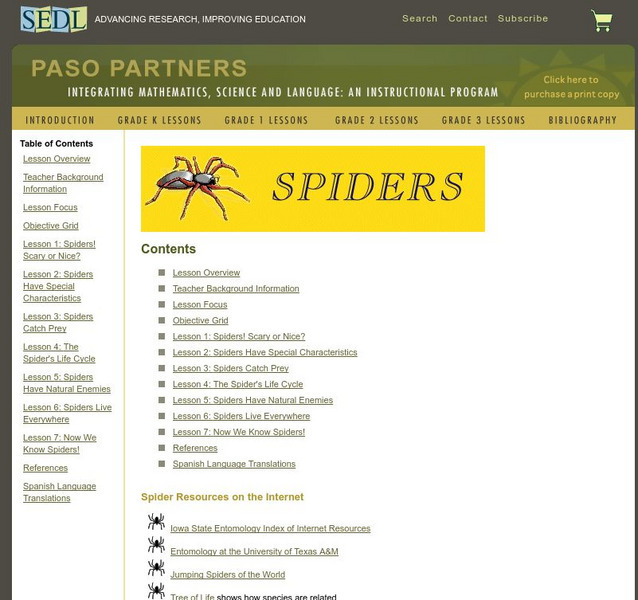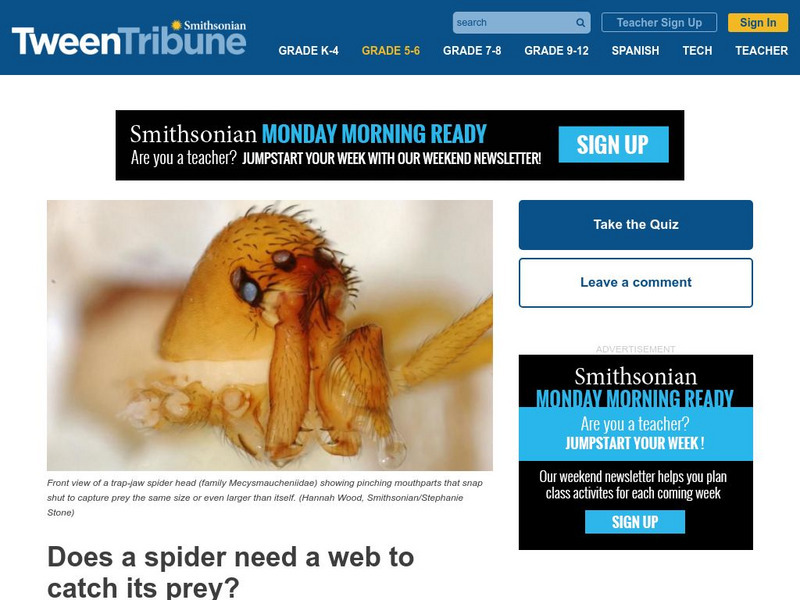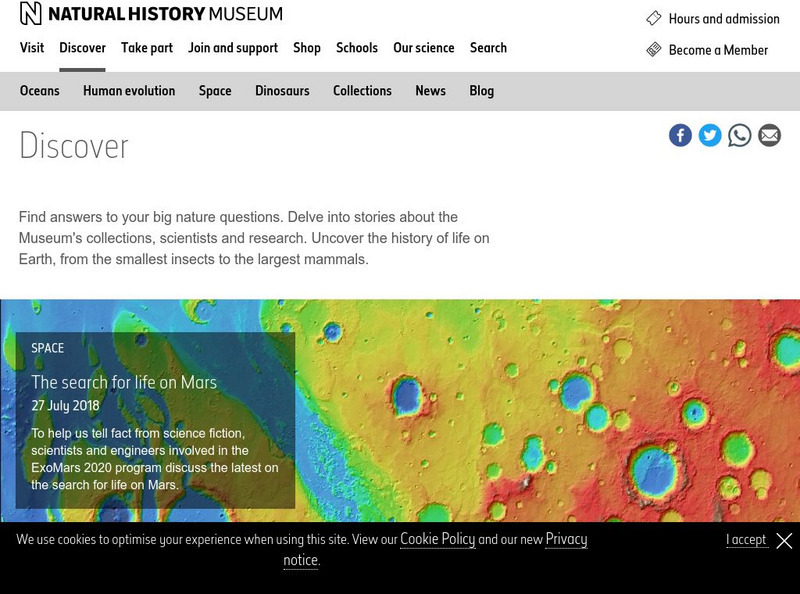BioEd Online
Bio Ed Online: Spiders in Space
With the help of videos and photos, students conduct open-ended scientific investigations to discover how gravity and microgravity affect the life cycle and web design of orb-weaver spiders on the International Space Station.
DOGO Media
Dogo News: Week of 4 4 16: Spiders Eat Their Greens Too!
Article reports on the diets of spiders, which includes vegetables.
University of Michigan
Bio Kids: Critter Catalog: Spiders
Spiders are easy to study as they are found everywhere. This page answers common questions about spiders, including classification information. It also has many excellent photographs of these critters and links to information on the most...
University of Florida
Florida Museum of Natural History: Animals 2: Insects and Spiders
This teacher's guide focuses on the smaller animals that inhabit our world: insects and spiders. These fascinating creatures provide young children many hands-on opportunities to learn about the diversity of living things, how living...
University of Wisconsin
University of Wisconsin: Black Spider Monkey
Taxonomy, morphology, range, habitat, and ecology are the topics explored in this in depth Black Spider Monkey site.
PBS
Pbs Nature: Spider
There are about 35,000 known species of spiders in the world and this research resource site surveys these animals in text and images.
Smithsonian Institution
Smithsonian National Zoo: Zoogoer Magazine: Surprising Spiders
Mary-Russell Roberson's article, "Surprising Spiders," deals with a variety of topics related to spiders in general, spider species, and spider facts. The focus is on spider types and species including the Brown Recluse, the Portia, the...
Burke Museum
Burke Museum of Natural History and Culture: The Spider Myths Site
Are spiders insects? Do you really swallow spiders while you're sleeping? Myths and questions related to spiders are addressed on this site. Links to additional information can also be found here.
SEDL
Sedl: Spiders
This is a wonderful resource for teachers who want to help children appreciate the place spiders have in the world and lessen their fear of spiders. Includes 7 sequenced lessons/units with detailed teacher notes, student activities,...
Other
Tarantula's Burrow: British Spiders What Is a Spider?
A list of characteristics that a creature must satisfy to be considered a spider, as well as a list with pictures and descriptions of spiders commonly found in the UK.
Burke Museum
Burke Museum: Dangerous Spiders
This site from the Burke Museum which is part of the collection of Arachnology from the Museum centers on correcting certain myths about so-called dangerous spiders. Scroll down to see the dangerous spider myths.
Society for Science and the Public
Science News for Students: Peacock Spider's Radiant Rump Comes From Teeny Tiny Structures
Male peacock spiders have highly colored hind ends that they shake to attract females. Scientists have now figured out the physics responsible for those hues.
How Stuff Works
How Stuff Works: Spiders
Basic facts about spiders, with links to related topics, photos and videos.
Smithsonian Institution
Tween Tribune: Does a Spider Need a Web to Catch Its Prey?
People are often fascinated by spiders creating their webs if they can catch a glimpse with the right lighting. Then there are the times people might get tangled in a web unintentionally. What do spiders do with those webs? Are they...
Library of Congress
Loc: Everyday Mysteries: Spiders and Their Webs
Have you ever wondered how spiders avoid getting stuck in their own webs? Check out this excellent explanation.
Read Works
Read Works: Calling All Spiders!
[Free Registration/Login Required] An informational text about different types of spiders found in North America. A question sheet is available to help students build skills in reading comprehension.
Natural History Museum
Natural History Museum: Insects and Spiders
As an online exhibit from the Natural History Museum, this site examines many different subtopics stemming from a study on both insects and spiders. Several of the subtopics include spider bites, bumblebees, moths, edible insects,...
Burke Museum
Burke Museum: Spider Identification
As part of the Arachnology section of the Burke Museum, this site corrects false conceptions associated with identifying spiders.
American Museum of Natural History
American Museum of Natural History: White Tailed Spider O Logy Card
Turn over this interactive card and start learning bite-size pieces of useful information about the white-tailed spider, such as their diet and physical characteristics.
Read Works
Read Works: Spooky Spiders
[Free Registration/Login Required] An informational text about spiders and the amazing things they can do. A question sheet is available to help students build skills in reading comprehension.
BiologyWise
Biology Wise: A Detailed Description of the Anatomy of Spiders
Describes anatomical features of a spider, including its external structure, eyes, mouth parts, digestive system, circulatory system, respiratory system, nervous system, reproductive system, and its spinnerets.
Soft Schools
Soft Schools: Spider Sense Quiz
Take this interactive, multiple-choice quiz over spiders, then review your score and any missed questions at the end.
Soft Schools
Soft Schools: Spiders All Over
Take this interactive, multiple-choice quiz over different types of spiders, then review your score and any missed questions at the end.
Other
Harry's Big Adventure: Lesson Plans: Spider and Insect Detectives
Lesson plans that include group activities and handouts to introduce students to the differences between spiders and insects.
Other popular searches
- Spiders Life Cycles
- Insects and Spiders
- Arachnids/ Spiders
- Black Widow Spiders
- Science Spiders
- Arachnids and Spiders
- Bats and Spiders
- Spiders and Science
- Spiders Crossword
- Arachnids Spiders
- Miss Spiders Tea Party
- Spiders and the Environment

















